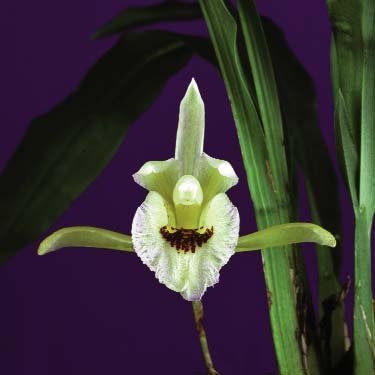Chondroscaphe eburnea is found in Panama, where the orchid grows epiphytic on trees in cloud forests on the Pacific slopes at an altitude of 800 to 1000 meters above sea level...
Chondroscaphe eburnea also called as The Ivory-Colored Chondroscaphe, is a species of the genus Chondroscaphe. This species was described by Robert Louis Dressler in 2001.
IDENTIFY CHONDROSCAPHE EBURNEA ORCHID PLANT
Chondroscaphe eburnea is found in Panama, where the orchid grows epiphytic on trees in cloud forests on the Pacific slopes at an altitude of 800 to 1000 meters above sea level.
It is a small to medium sized, warm growing epiphyte without pseudobulbs and carrying 3 to 4, narrowly oblanceolate, acuminate, acute, conduplicate below, 15-37 cm long and 2.5-4 cm wide leaves.
The Ivory-Colored Chondroscaphe blooms on a basal, 5 cm long, single flowered inflorescence occuring in the late spring and early summer. The flowers are creamy-green with a white lip and a small fraction of red-purple spots inside the lip. Upper sepals elliptical or oval-elliptical, with pointed tip, with curved edges, about 2.5-2.7 cm in length and 0.9-1 cm in width. The lateral sepals are elongated-lanceolate, with sharpened hooked tips, measuring 3.5-3.8 cm in length and 0.9-1 cm in length. Petals in color from cream to yellow-cream, egg-shaped or lanceolate, with rather long pointed tips, but also with rounded ends, measuring 2.7-3 cm in length and 1-1.2 cm in width. The lip is triple, oval, 3 to 3.5 cm in length and 2.2-2.7 cm in width, the anterior part has a kind of pointed tip, the inside of the lip is covered with purplish spots and has denticles (0.6 cm in length) . The column is 1.4-1.5 cm long and 0.75 cm wide.
CHONDROSCAPHE EBURNEA ORCHID PLANT CARE AND CULTURE
Cultural information should only be used as a guide, and should be to be adapted to suit you. Your physical location; where you grow your plants, how much time you have to devote to their care, and many other factors, will need to be taken into account. Only then can you decide on the cultural methods that best suit you and your plants.
Light:
Chondroscaphe eburnea is grow in bright scattered light. The ideal location is considered to be the south-east and east orientation windows, however, if there are none in the apartment, then you can use western or very bright northern windows. If the western or southern windows were chosen for the location of the plant, then during the period from May to early September, the orchid should be protected from the influence of too bright day and evening sun - put behind a curtain (for example, on a table near a window) or into the shade of other plants.
Temperature:
This type of orchid refers to a moderately warm temperature regime, and throughout the year orchids are grown under the following conditions: Day temperature at 18-25 ° C (maximum 30 ° C); Night temperature is not below 15 ° C. For the successful cultivation at home, it is necessary that the night temperature of the content is always 3-5 ° C lower than the daytime temperature.
Humidity:
The Ivory-Colored Chondroscaphe needs relatively high humidity, not less than 60%, ideally 75-80%. Too dry air adversely affects the development of the plant and its growth is inhibited, and the leaves turn black and dry up.
Substrate, growing media and repotting:
Chondroscaphe eburnea is grow only in pots. As a substrate, it is recommended to use a mixture of bark of coniferous trees with the addition of chopped fern, sphagnum moss and dry leaves. Repotting is recommended only when it is really necessary. For example, in cases of severe salinization or compaction of the substrate, too high or low its pH (norm from 5.5 to 6.5) or when the orchid grows very much and the pot becomes too small. The best time for transplant is the period immediately after flowering and until the moment when new sprouts begin to build up their own roots.
Watering:
Watering this kind of orchids directly depends on the total temperature of the content, the higher it is, the more often and abundant it will be necessary to water. When watering orchids in pots, it is necessary to remember that excess water during watering should flow freely out of the pot, as the stagnation of water both inside the pot and in its pallet can very quickly lead to rotting of the roots and the lower part of the plant. The substrate between the irrigations should dry relatively well, but do not dry out completely, i.e. always be in a slightly moistened state.
Fertilizer:
Throughout the year, this type of orchids is fertilized every 2-3 weeks in 1/4 of the concentration of fertilizer indicated on the package. In addition to the usual root top dressing, it is also recommended to produce a foliar dressing, when a very much diluted fertilizer is sprayed on the outer part of the plant. It is best to feed the orchid, alternating both these methods. At the beginning of the growing season (the appearance of new shoots) it is recommended to use fertilizer with a higher nitrogen content, and when the new sprout reaches 1/2 of its normal size - a fertilizer with a high content of phosphorus.
Rest period:
Chondroscaphe eburnea does not have any period of rest, neither during the winter period, nor for stimulation of flowering. After flowering, the flower stem is removed only when it begins to dry up on its own, since the main feature of the orchids of this species is a repeated flowering on the same peduncle. After one flower fades, the flower stem can lengthen, forming a new bud. In addition, immediately after flowering, if necessary, the orchid is transplanted and kept relatively dry for some time. This is necessary to acclimatize the plant and to prevent rotting of the roots from the transplant.















COMMENTS